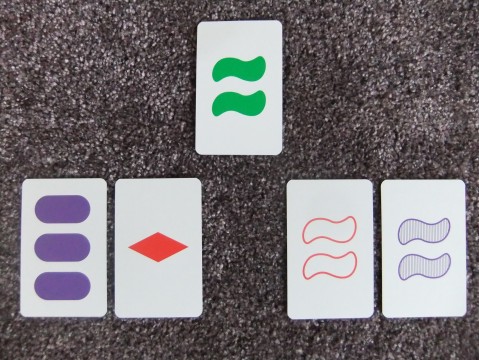I recently got an e-mail from Michael Sherman, a teacher in New York. He had developed a variation of the card game Set called Complementary Pairs. This is how he described it:
“We have Set competitions at the school where I teach, both as individual time trials and as head-to-head matches. When many students at my school became capable of finding sets very quickly, I developed what I called C.P. Set (Complementary Pairs) to slow them down a bit and reduce the number of simultaneous calls in the head-to-head matches. The idea is to find two pairs of cards that both require the same 3rd card to complete a Set. The completing card does not need to be on the board; only the four cards forming the complementary pairs are picked up.”
The picture below shows two pairs that have the same third card. The two cards to the left (pair 1) form a set with the top card. Likewise, the two cards to the right (pair 2) also form a set with the top card. Therefore, pair 1 and pair 2 are complementary.
At Michael’s school, they started out playing Complementary Pairs Set with 12 cards on the table, but soon realized that they could also play with only 9 cards on the table. So if the four cards in the picture above (pair 1 and pair 2) were present anywhere among the 9 cards on the table, they could be removed as complementary pairs, and be replaced by four new ones. Note that the third card (the top card in the picture) doesn’t have to be present on the table.
Michael had read my first post on Set probabilities, and was wondering what the chances are of not finding any complementary pairs when playing with 9 cards on the table. He asked if I could find the answer by modifying my simulator. With 9 cards on the table, there are 36 different possible pairs. For each pair, there is exactly one card that can form a set with it. So the question is: how often does it happen that all the 36 pairs require a different third card (of the possible 81 cards) to form a set?
It turns out that it is very rare that there are no complementary pairs present among 9 cards. When I simulated playing one million games, the odds of there not being any complementary pairs were around 12,000 to 1. Put another way, it only happened around 80 times out of a million. The odds were constant per round of play, which is not surprising, given that the third card doesn’t have to be present on the table. The Java program I used is available at BitBucket.
After Michael came up with the idea of complementary pairs, he found out that the same variation of Set had already been proposed, but under the name of Super Set. However, I think complementary pairs is a more descriptive name, so I’ll stick to that.
If you haven’t yet tried Complementary Pairs Set, give it a try. And if you can’t find any complementary pairs, look harder – the odds of there not being any are 12000:1. Happy playing!


I’m pleased to see this validation of “Super Set”, which I’d only been aware of through word of mouth. The initial difficulty of finding pairs had me skeptical that it was a feasible variant, but this arms me with the courage to persevere.
I tested the difficulty of C.P. Set (SuperSet) before introducing the game to the students, and found that with a little practice this variation can play almost as smoothly as a regular Set game. It did require persisting through the first couple attempts, which went slowly. But after a week of playing through the deck once or twice each day, I could usually finish a game in under ten minutes when using a 12 card board. (Using only 9 cards adds significantly to the challenge, for those who become adept with the larger board.)
I’ll mention that I learned not to think much about the “third card” when playing C.P. Set. It’s more a matter of learning to see the patterns that form complementary pairs. (A-A & A-A, A-B & A-B, or A-A & B-C, for each property.)
In my experience, the large number of C.P. sets available on a 12 card board makes it possible to focus on pairs with more similarities, as the easiest to spot at a glance. (We might define complexity levels 0-4 for C.P. sets, based on the number of A-A & B-C matchings, with Henrik’s example picture having complexity level three. Envision the left hand pair in the picture as double green squiggles, clear and striped, for an example of a set with complexity level one.)